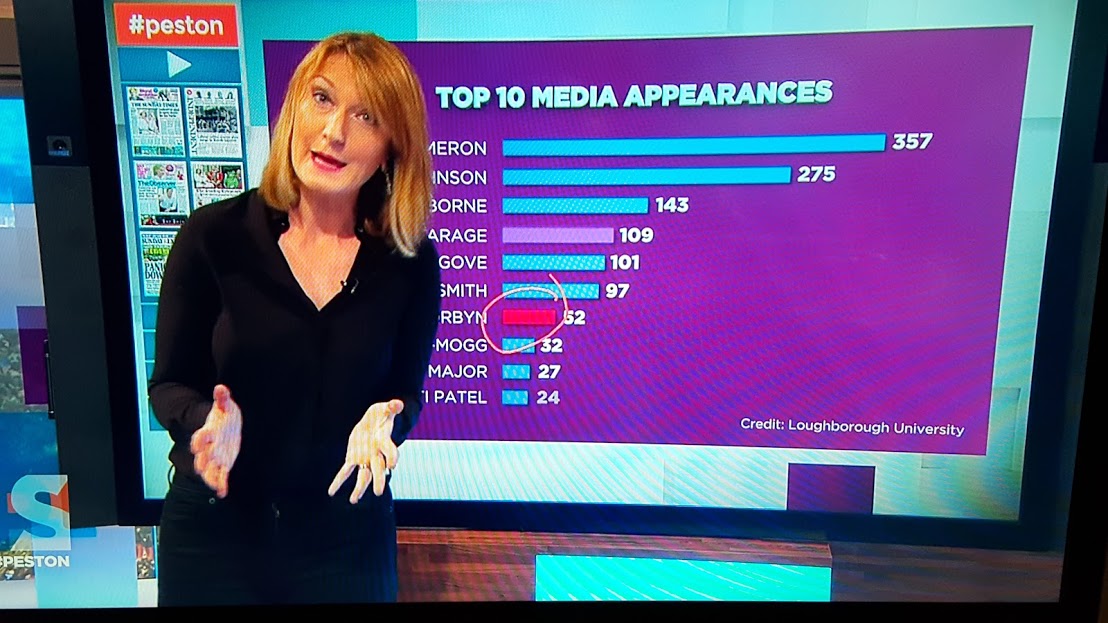
Media coverage of the EU Referendum (report 3)
This is the third report by the Loughborough University Centre for Research in Communication and Culture (CRCC) on national news reporting of the 2016 EU Referendum.
The results in this report are derived from detailed content analysis of news coverage of the EU Referendum produced on the weekdays (i.e. Monday to Friday inclusive) between 6 May and 8 June 2016 from the following news outlets:
Television: Channel 4 News (7pm), Channel 5 News Tonight (6.30pm), BBC1 News at 10, ITV1 News at 10, Sky News 8-8.30pm.
Press: The Guardian, The Times, Daily Telegraph, Financial Times, Daily Mail, Daily Express, Daily Mirror, The Sun, Star and the I.
We analysed all EU Referendum related news found in the entire duration of all the above named television programmes. For the press, we included referendum news found on the front page, the first two pages of the domestic news section, the first two pages of any specialist election section and the page containing and facing the papers’ leader editorials. Inter-coder reliability tests were conducted to check the robustness and consistency of these measures (see the website for more information).
Regarding our terminology and coding protocols: we use the term ‘IN’ to indicate individuals and organisations supporting the case for the UK to remain in the European Union. We use the term ‘OUT’ for those advocating the UK’s departure from the EU. We do not categorise people or organisations according to our prior knowledge of their political viewpoints. Rather, individuals or organisations are only assigned to these categories when their affiliations are manifestly stated in editorial content and/or they articulate support for one of these positions.
This report has four sections, assessing:
- Directional Balance– how strongly are individual national newspapers supporting arguments for remaining in, or leaving, the EU?
- Issue Balance – which topics have received most coverage and how has the news agenda developed over the campaign?
- Stopwatch Balance – which individuals or institutions have featured most frequently?
- Gender Balance – what is the proportional coverage of women and men in coverage? Are women gaining more of a voice
Executive Summary
Our analysis of ‘directional balance’ focused on the national press. By combining long-term measures of their reporting and the extent to which these align with IN or OUT positions we have developed a ‘continuum of opinion’ as to newspapers’ stance on the Referendum.
The CRCC continuum of opinion
| Strongest support for IN | 1. Financial Times |
|---|---|
| 2. The Guardian | |
| 3. Daily Mirror | |
| 4. I | |
| Weakest support for IN | 5. The Times |
| Weakest support for OUT | 6. Daily Telegraph |
| 7. The Sun | |
| 8. Star | |
| 9. Daily Mail | |
| Strongest support for OUT | 10. Daily Express |
- There are five newspapers on either side of the debate. Across these titles a significant minority of news items have provided a balanced or neutral account of the competing positions. However, if we look at the volume of articles that clearly orientate to a particular stance, the ratio of OUT supporting items to IN is about 60:40. If we take circulation into account, and hence consider the audience reach of these items, the ratio of OUT: IN rises to around 80:20.
- The debate is highly presidential in character, focussing on key individuals. The top six individuals are all right-of-centre and are all men. Despite concern expressed by left-of-centre and female politicians about media coverage it’s still largely a ‘Tory story’ and a male dominated, ‘blue-on-blue’ tale at that.
- The campaign is being fought out over two main substantive issues – the economy and immigration – that are presented as having implications for other areas of policy (e.g. health, crime). In week 4 immigration was to the fore, good news for OUT, but in week 5 economic issues regained their lead, good news for IN.
Section 1: Directional Balance: Newspapers and the ‘continuum of pinion’
This section is concerned with the issue of ‘directional balance’ in coverage – i.e. the extent to which coverage within news media tends to incline towards arguments supporting an IN or OUT decision. In this report, we focus on patterns of press partisanship and, in so doing, go beyond a simple categorisation of the newspapers and number of titles supporting the respective camps. Although the Referendum will ultimately be decided by a stark two-way decision, the public vote will be informed and influenced by a far more nuanced debate, ranging from strong advocacy of remaining in the EU through to ardent support for the UK’s departure.
In this section, we use a combination of measures to determine where the UK national newspapers sit on this ‘continuum of opinion’. In positioning newspapers on this scale, we do not rely on positions stated or implied in leader editorials so far in the campaign. Although these are suggestive of the newspapers’ final declarations, the tone and content of editorials can be obscure and, sometimes, contradictory. Instead, our ranking is based on a scoring of each news item published in our sample period according to the following measures.
- If an item mainly or solely focused on matters or opinions supporting the IN position, it was given a value of +1.
- If an item mainly or solely focused on matters of opinions supporting the OUT position, it was given a value of -1.
- Items where there was no clear evaluation, or contained positive and negative issues for both positions in broadly equal measure, were coded as zero.
- We use this scale to calculate two measures: (1) volume – the total number of pro-IN items subtracted by the number of pro-OUT items, (2) average – the mean score for items published by individual titles on this scale.
- ‘Volume’ measures the aggregate of pro-IN to pro-OUT coverage, ‘average’ measures the extent to which coverage in a title is pro-IN or pro-OUT, when it occurs.
- Positive values for either measure indicate a pro-IN orientation, negative values reveal a pro-OUT orientation. The further either value is from zero, the stronger the partisanship of coverage on the continuum.
- NB We appreciate the controversy surrounding the positivity or negativity of the respective campaigns. For this reason, the decision to assign IN stories with a positive value and OUT stories with a negative value was decided by the flip of a coin[1].
Findings
Before assessing the specific scores of different titles, it is important to note that a significant minority of press items either conveyed a balanced and/or neutral treatment in their referendum coverage. Figure 1.1 shows how these proportions varied according to different titles.
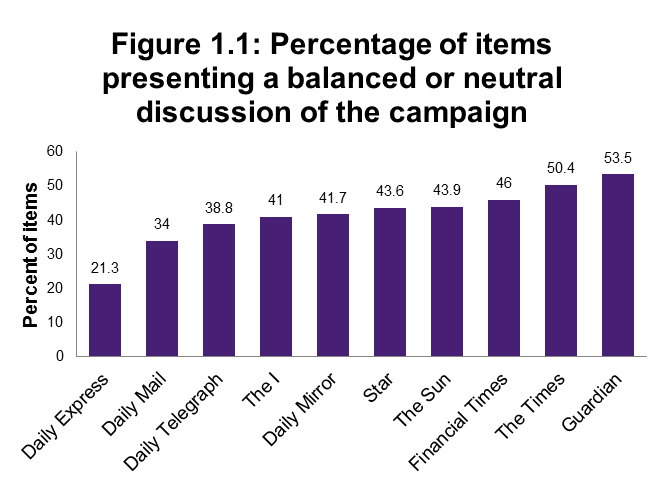
Figure 1.1: Percentage of items presenting a balanced or neutral discussion of the campaign
Key findings
- In rank order, the Express, Mail and Telegraph had the lowest percentage of items presenting a balanced or neutral discussion.
- Also in rank order, The Guardian, Times and Financial Times had the highest percentage of such items.
- The Express is a clear outlier in this distribution, with only 21.3% of items coded as balanced or neutral.
The distribution does not map neatly onto traditional means of differentiating the UK press sector as ‘popular’ (i.e. Daily Mirror, Star and The Sun), ‘mid-market’ (Daily Express and Daily Mail) and ‘quality’ (Daily Telegraph, Financial Times, Guardian and The Times) newspapers.[2] This suggests these differences cannot be explained entirely by differing conventions regarding the presentation of political news. For example, the positioning of The Sun – a paper not renowned for editorial equivocation – is particularly noteworthy.
Discussion now turns to the distribution of coverage where a clear orientation in coverage was discernible. Figure 1.2 compares the volume of pro-IN to pro-OUT coverage for different newspapers.
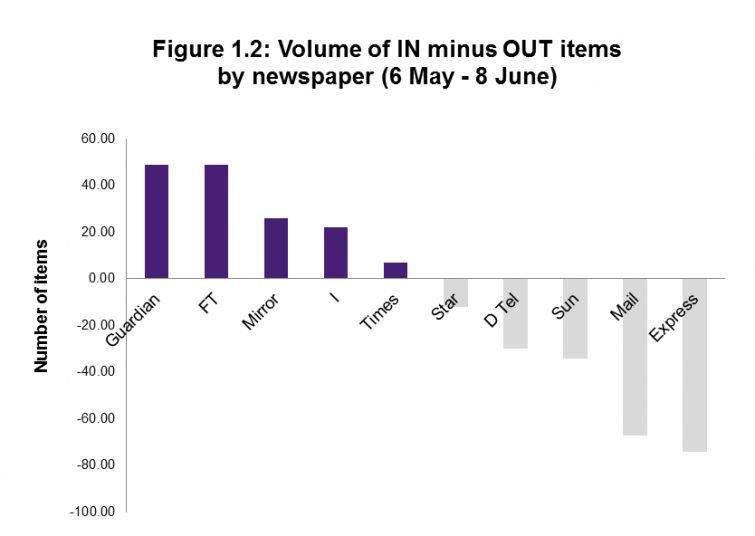
Figure 1.2: Volume of IN minus OUT items
by newspaper (6 May – 8 June)
Key findings
- The Guardian and Financial Times’ coverage have produced the greatest surplus of pro-IN news items for the sample period
- The Daily Mirror, the I and The Times are (in rank order) of the next most pro-IN news items.
- The Daily Express has published the greatest surplus of pro-OUT news items, followed by (in rank order) the Daily Mail, The Sun, Daily Telegraph and the Star.
The volume measure does not take account of the varying extent to which particular titles dedicate coverage to reporting public affairs and the different sizes of these newspapers (and hence available news space). Given this Figure 1.3 controls for these factors by comparing the average scoring of EU referendum coverage by newspaper (i.e. on average do items tend to be positive or negative when they occur?). This measure changes the positioning of some newspapers on the continuum of opinion set out in Figure 1.2.
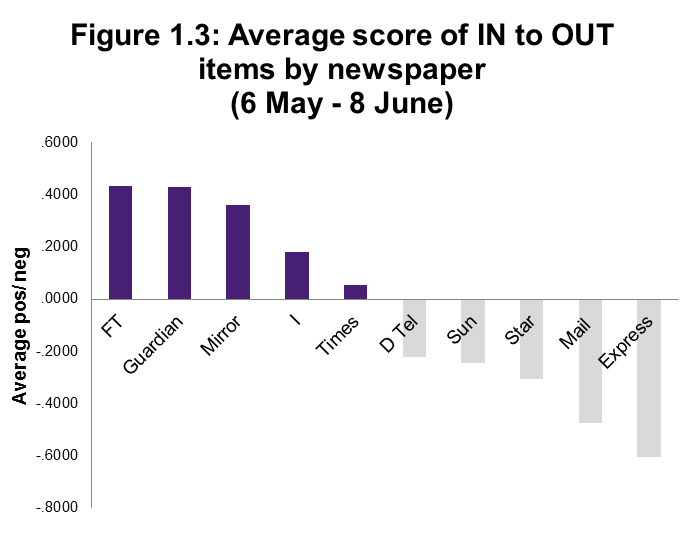
Figure 1.3: Average score of IN to OUT items by newspaper
(6 May – 8 June)
Key findings
- Accordingly the FT becomes the most pro IN title, slightly shading the Guardian.
- The Star, The Sun and Daily Telegraph change position. The Telegraph and Sun move towards the centre as the Star is placed in a more pro OUT positioning.
- The Express and Mail, in that order, remain the most pro OUT newspapers.
To decide on a final ranking of national newspapers on the IN/OUT continuum we have ranked and combined both of the ‘volume’ and ‘average’ scores for each title in Table 1.1.
Table 1.1 Aggregated rankings of newspapers on the IN/OUT continuum
| Overall | Volume | Average | |
|---|---|---|---|
| (From most pro-IN… ) Financial Times | 1 | 1 | 1 |
| Guardian | 1.5 | 1 | 2 |
| Daily Mirror | 3 | 3 | 3 |
| I | 4 | 4 | 4 |
| The Times | 5 | 5 | 5 |
| Daily Telegraph | 6.5 | 7 | 6 |
| Daily Star | 7 | 6 | 8 |
| The Sun | 7.5 | 8 | 7 |
| Daily Mail | 9 | 9 | 9 |
| Daily Express (… to most pro-OUT) | 10 | 10 | 10 |
Commentary: it’s not as equal as it may seem
The results set out in this section suggest that newspaper coverage about staying or leaving the EU is, in broad terms, equally divided. Judged by their reporting five newspapers are currently aligned with IN, five with OUT. Moreover, if we aggregate the scores for all newspapers we find that of the 1127 items sampled there was only a 64 article surplus in favour of OUT compared with IN. The average overall score is (minus) 0.00568, placing the total news position more or less equidistant between the polarities of IN (+1) and OUT (-1). However, these figures give no consideration to the different reach of newspapers. When the orientation and intensity of press coverage is weighted by circulation, a significant gulf opens up between IN and OUT coverage (see Figure 1.4).A straightforward percentage comparison of the number of IN to OUT items finds 41% were pro-IN and 59% pro-OUT. But when weightings for circulation are factored in, this comparison changes and widens into a substantial difference of 18% pro-IN and 82% pro-OUT. Most of the Out newspapers also have a significant C2DE readership and these may be crucial groups in determining the outcome of the Referendum vote.[3]
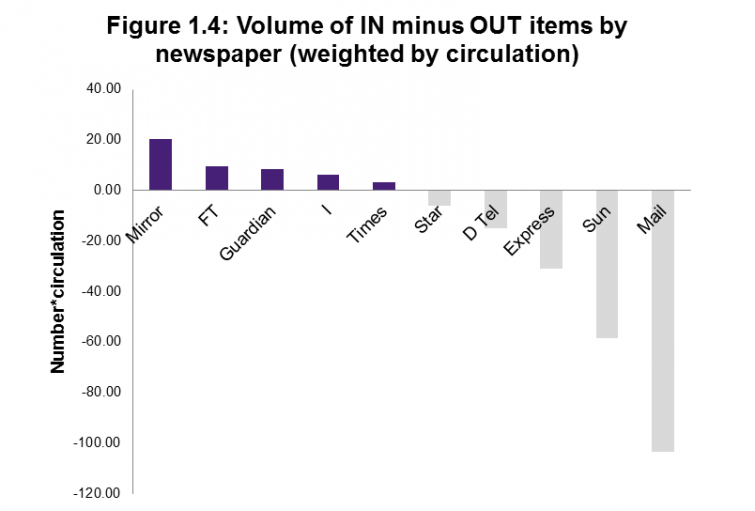
Figure 1.4: Volume of IN minus OUT items by newspaper (weighted by circulation)
Section 2: Issue Balance
This section examines the issue agenda in the reporting of the referendum during the sample period. What issues have dominated coverage so far, and what have failed to attract much attention? And has there been any shift in the media agenda on a week by week basis? Table 2.1 identifies the most prominent issues in TV and press across our entire sample period.
Table 2.1: Most prominent issues in TV and Press (6 May – 8 June)
| TV | Press | |
|---|---|---|
| % | % | |
| Referendum conduct/process | 25 | 30 |
| Economy/business | 21 | 20 |
| Immigration | 16 | 13 |
| Public opinion/ citizen engagement | 12 | 6 |
| Constitutional/legal/judicial | 5 | 7 |
| Defence/security/terrorism | 4 | 5 |
| Employment | 5 | 4 |
| Health/health care | 1 | 3 |
| Standards/corruption | 1 | 3 |
| EU structure/operation | 2 | 2 |
| Housing | 1 | 1 |
| Foreign policy (outside EU) | 1 | 1 |
| Crime/law and order | 0 | 1 |
| Public services | 1 | 1 |
| Social security | 1 | 1 |
| Taxation | 1 | 1 |
| Environment | 0 | 1 |
| Other issues | 3 | 0 |
Key findings
- Reporting of the conduct and process of the Referendum has been the largest feature of coverage so far.
- Coverage of economic and business issues is the most prominent substantive topic in press and TV.
- Immigration is the third most prominent issue, being more prominent in TV news than the press.
- Coverage of citizen engagement and public opinion is also prominent, most notably in TV news coverage.
- There is a considerable degree of consistency of coverage of issues across press and television news. There is a shared inattention to matters such as the environment, devolution, agricultural policy, social security and public services.
Whole sample counts of the above kind can obscure recent fluctuations in the news agenda. Table 2.2 compares issue prominence for the most recent weeks (4 and 5) of our sample.
Table 2.2: Issue balance (week 4 & 5)
Key findings
- The results show some change over the last two weeks. For example, ‘health/health care’ and ‘crime/ law and order’ have gained prominence.
- Some issues have reduced in news worthiness e.g. ‘employment’ and ‘defence/military/security’.
- The biggest change has been in the respective coverage of ‘immigration’ and ‘economy/business’, with an almost direct reversal of their prominence.
Figure 2.1 compares the relative prominence of ‘immigration’ and ‘economy/ business’ on a week-by-week basis.
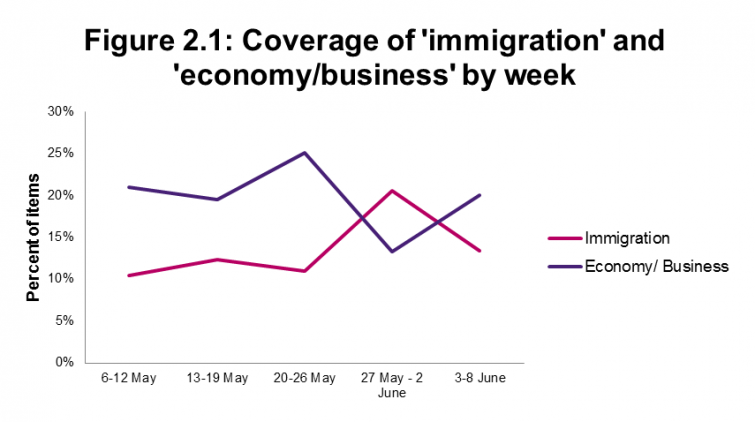
Figure 2.1: Coverage of ‘immigration’ and ‘economy/business’ by week
Key findings
- The prominence of ‘immigration’ in week 4 (27 May – 2 June) was a one-off.
- In week 5 coverage of economy/business has re-established its primacy in the news agenda.
Commentary
This remains a very constrained news debate about the Referendum and its implications. Many significant matters have been side-lined (the environment, the implications for devolution, social security issues, agriculture, etc). Despite this, the results show that the dynamics of the issue agenda are far from static. In week 4, immigration came to the fore of news coverage, having lagged behind discussion of the economy and business in preceding weeks. In the most recent week, there has been a switch back towards the economy. The relative prominence of these issues will become a matter of ever growing importance. It has become self-evident that the OUT campaign wishes to fight the referendum on the issue of immigration and the IN campaign on the economy and they will continue to battle it out over these two issues until voting day. Their collective dominance of two substantive issues, the economy and immigration, reflects the extent to which this is a campaign fought on the terrain of the political centre-right. It is difficult to see this changing in the last weeks of the campaign with the IN campaign stressing economic grounds for remaining and the OUT campaign emphasising the issue of immigration. This may prove a problem for the IN campaign in terms of persuading potential supporters on the centre-left to get out and vote as their reasons for potentially supporting the IN campaign have received less attention.
Section 3: Stopwatch Balance
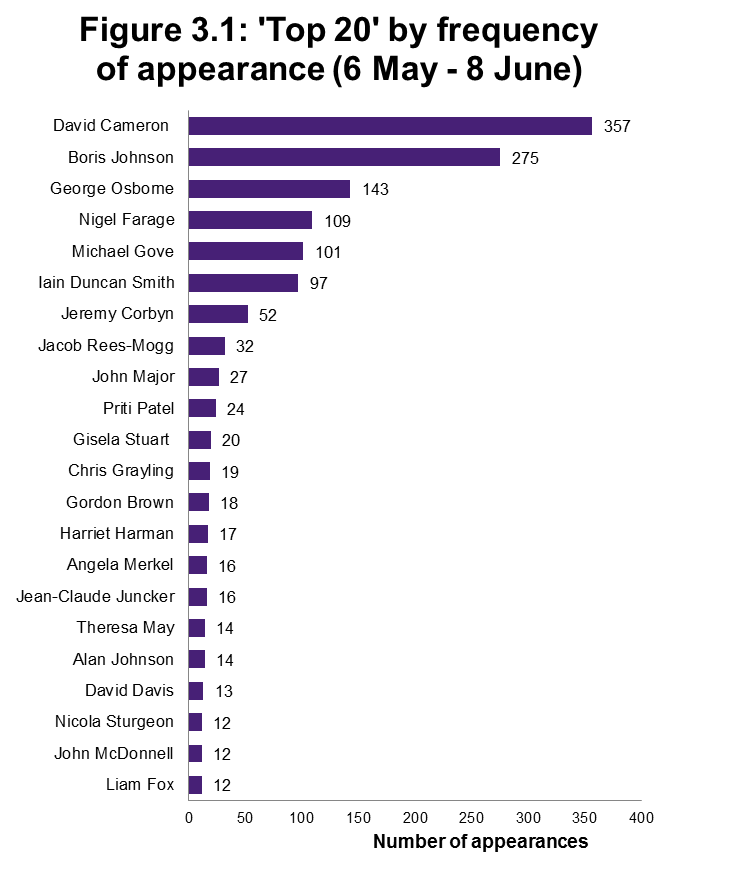
Figure 3.1: ‘Top 20’ by frequency of appearance (6 May – 8 June
This section examines which individuals, organisations and institutions received most media coverage for the sample period. Figure 3.1 shows the ‘top twenty’ most frequently reported individuals over the last month.[5]
Key findings
- Coverage of the campaign has been highly presidential and dominated by Conservative representatives from both camps. The IN cause is heavily dependent on the Prime Minister and Chancellor as its main media spokespeople and the OUT campaign on Boris Johnson, Michael Gove and Iain Duncan Smith.
- Female campaigners appear in the top twenty, albeit the highest ranked appearance is Priti Patel in tenth place.
- There is a dearth of representatives from the non-Conservative parties in the top twenty, with Nigel Farage and Jeremy Corbyn gaining a slot and Nicola Sturgeon, the SNP leader, only just making it in joint 20th.
- The interventions of the President of the European Commission Juncker and Angela Merkel, German Chancellor, have meant they have also featured to a greater extent than Home secretary Theresa May, Shadow Chancellor John McDonnell and Alan Johnson, the leader of Labour’s IN campaign.
Table 3.1 aggregates individuals and groups by wider categories (e.g. by political party).
Table 3.1: News presence of groups/organisations/institutions
| TV | Press | |
|---|---|---|
| % | % | |
| Conservative | 32 | 44 |
| Labour | 6 | 9 |
| Lib Dem | 1 | 1 |
| UKIP | 2 | 4 |
| SNP | 1 | 1 |
| Other parties | 0.1 | 0.1 |
| Business | 5 | 6 |
| Media | 4 | 2 |
| Experts | 6 | 4 |
| Union | 0.4 | 1 |
| Citizens | 26 | 4 |
| Other Referendum pressure group | 4 | 8 |
| NGOs | 0.4 | 1 |
| Government agencies | 4 | 7 |
| Other UK | 0.8 | 1.9 |
| EU organisations | 0.3 | 2 |
| Other International organisations | 2 | 1 |
| Other non UK | 5 | 3 |
Key findings
- The Conservative party has dominated news coverage on TV and the press; although present other political parties have, in contrast, received a fraction of their coverage.
- The coverage of business sources and experts has been much greater than trade unionists on both TV and in the press.
- There is a marked contrast in the appearance of citizens in the news between TV and the press. While on TV citizens are highly visible, in press reports they are almost entirely absent.
- Media sources (including celebrities) have also been more prominent on TV than in the press.
Commentary
Over the last month of the campaign there has been sustained focus on a handful of senior Tory party politicians. The dominance of the Conservative party and a select group of key figures has overshadowed the coverage of all other party representatives and other groups and institutions. Coverage of Labour and leading Labour politicians could hardly be more different. John McDonnell and to a lesser extent Jeremy Corbyn have been very marginal in coverage, indeed on TV the ordinary citizen has had more say, although the views of citizens (and discussions of public opinion) have not been key in press reports. Business sources have received almost as much coverage as Labour, more than the other minor political parties and much more than the trade unions.
Section 4: Gender Balance
The marginal presence of women in coverage of the Referendum has been the subject of considerable comment throughout the campaign. Table 4.1 compares the relative prominence of women to men in TV and press reporting over our entire sample.
| Media | ||
|---|---|---|
| TV % | Press % | |
| Female | 24 | 13 |
| Male | 76 | 87 |
Key findings
- Women are outnumbered by men by 3:1 on television.
- Women remain marginal in press coverage, accounting for just 13% of all individuals.
- Television features substantially more women than the press.
Figure 4.1 breaks these general distributions down by sample weeks.
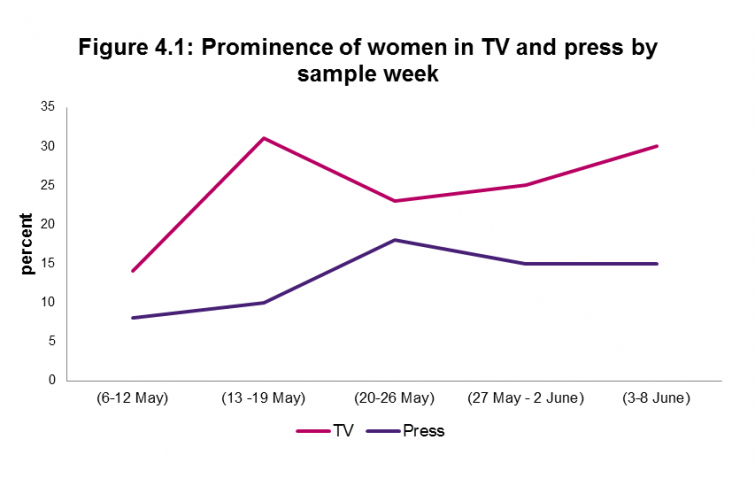
Figure 4.1: Prominence of women in TV and press by sample week
Key findings
- TV news has consistently given greater prominence to women compared to the press.
- Women’s presence increased in week 2 (13-19 May) for TV but remained more or less static in the press.
- In week three (20-26 May), the difference narrowed, but has widened over the last two sample weeks (27 May-8 June).
- At no time has the proportion of women in the press exceeded 20%.
- The proportion of women remains stubbornly below 20% overall.
Commentary
Starting from a very low base, both TV and press have given more time and space to women over the course of the campaign. This tendency is much more pronounced in TV news, reflecting broadcasters’ obligations to be balanced and impartial in their coverage. This rise may be a consequence of complaints about the lack of female voices expressed most forcefully by Harriet Harman. That said, the proportion of women remains under 20% overall.
[1] Our thanks to Meetal Ravalia.
[2] Since its launch in 2010 the I newspaper defies easy categorisation because it combines elements of both a mid-market and quality title
[3] Thanks to the University of Southampton’s Will Jennings for the following link to data on Referendum voting intention by newspaper readership as well as other categorisations.
[4] NB at the time of going to press we didn’t have the data for the final day, 9th June, of this most recent week of the campaign but if we had this is unlikely to have significantly altered the identified trends in Table 2.2.
[5] NB there are actually twenty two campaigners in this ‘top twenty’ because the last three share 20th= position.